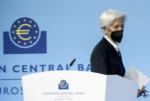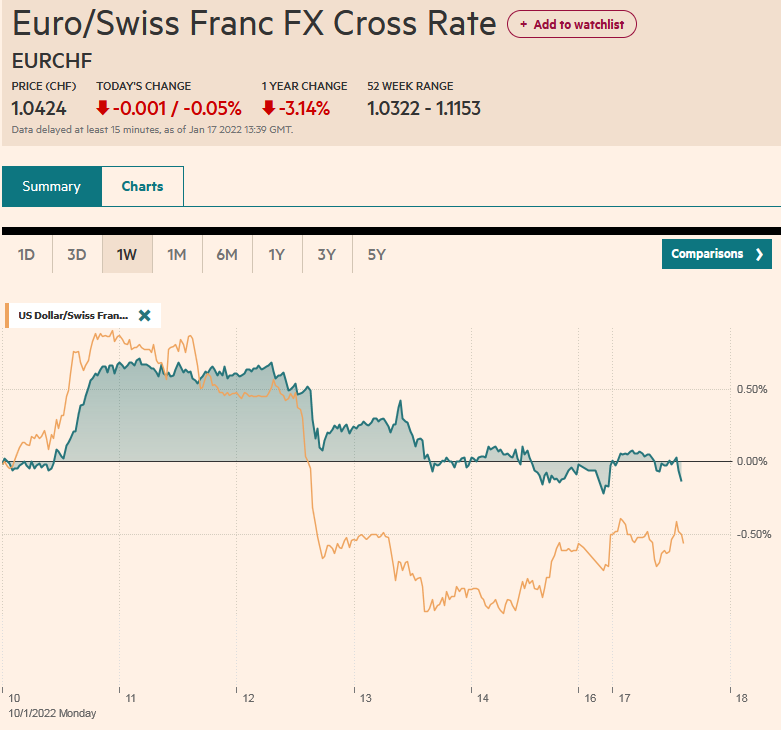Overview: Asia Pacific equities were mostly lower. China and India bucked the trend. Europe’s Stoxx 600 is steady with no follow through selling after yesterday reversal. US index futures are posting modest gains and are trying to snap a two-day drop. The US 10-year yield is firm at 2.91%, while European benchmark rates are 2-3 bp higher. Asia Pacific bonds were dragged lower by the sell-off in the US yesterday. The dollar is broadly lower. The Swedish krona and sterling are faring best among the majors. The Canadian dollar is the laggard today, little changed near midday in Europe. Emerging market currencies are more mixed. The South Korean won was thumped by 1.2% and the Philippine peso is off by 0.6% to lead the losers, while, leaving aside the
Topics:
Marc Chandler considers the following as important: 4.) Marc to Market, 4) FX Trends, Australia, Bank of Canada, Currency Movement, ECB, Featured, Federal Reserve, Japan, Mexico, newsletter, OPEC, USD
This could be interesting, too:
Nachrichten Ticker - www.finanzen.ch writes Die Performance der Kryptowährungen in KW 9: Das hat sich bei Bitcoin, Ether & Co. getan
Nachrichten Ticker - www.finanzen.ch writes Wer verbirgt sich hinter der Ethereum-Technologie?
Martin Hartmann writes Eine Analyse nach den Lehren von Milton Friedman
Marc Chandler writes March 2025 Monthly
Overview: Asia Pacific equities were mostly lower. China and India bucked the trend. Europe’s Stoxx 600 is steady with no follow through selling after yesterday reversal. US index futures are posting modest gains and are trying to snap a two-day drop. The US 10-year yield is firm at 2.91%, while European benchmark rates are 2-3 bp higher. Asia Pacific bonds were dragged lower by the sell-off in the US yesterday. The dollar is broadly lower. The Swedish krona and sterling are faring best among the majors. The Canadian dollar is the laggard today, little changed near midday in Europe. Emerging market currencies are more mixed. The South Korean won was thumped by 1.2% and the Philippine peso is off by 0.6% to lead the losers, while, leaving aside the rouble, the Hungarian forint is the strongest, up about 0.8%. The central bank hiked the one-week deposit rate by 30 bp to 6.75%. Gold is extending yesterday’s recovery from around $1828, a two-week low, and is probing the $1855 area. After testing $120 earlier this week, July WTI is trading around $112.50 ahead of the OPEC+ decision on next month’s output. There is speculation that the pact between OPEC and non-OPEC may be unraveling. US natgas jumped 6.75% yesterday, its biggest rise since mid-April. It is a bit firmer today. Europe’s benchmark fell almost 6% yesterday but is bouncing back more than 4% today. Iron ore surged by 5.8% in Singapore and is at its best level in a month. Copper is up 2% and is at levels not seen since late April. July wheat is trying to stabilize after falling more than 10% in the past two sessions.
Asia Pacific
The Bank of Japan reported its balance sheet shrank by 0.7% in the past ten days. Its holdings of government securities edged up by 0.2%, corporate bonds by 0.5%, and commercial paper 0.3%. These increases were offset in full by the 4.5% decline in loans. There is no policy implication here, and despite the 2% increase in wages settlements in March and the upward pressure on inflation, where the core has met the 2% target, the BOJ has been clear that it is too early to tighten policy.
Australia's energy regulator will allow a 4%-14% increase in electric bills starting next month. Between this and the increase in gas prices, Q3 CPI is likely to rise by around 0.4%. This is seen clearing the way for possibly more aggressive tightening of monetary policy. The swaps market has a little more than a 30 bp hike discounted for next week's RBA meeting. Separately, Australia reported a larger than expected April trade surplus of A$10.50 bln. Exports rose 1% and imports fell by 1%. Coal exports rose 6% and iron ore shipments increased by 2.6%, while gold exports jumped 18%. The impact of the lockdowns in China were evident as Australia's exports fell 2.9% and imports were off a little more than 14%. Australia's positive terms-of-trade shock can be appreciated by comparing this year's trade surplus (average A$10.2 bln) to the first four months of last year (~A$8.6 bln) and the same period in 2019 (~A$4.3 bln).
The dollar extended yesterday's gains against the Japanese yen to reach almost JPY130.25, its highest level since May 11. The multiyear high was recorded a couple of sessions earlier at JPY131.35. Not coincidentally, the 10-year US yield rose nearly 17 bp over the past two sessions coming into today. The exchange rate has been consolidating since early in the Asian session. Support is seen near JPY129.60. After peaking yesterday near $0.7230, the Australian dollar backed off to $0.7040 today before finding a bid that lifted it back near $0.7200. The intraday momentum indicator is stretched. Initial support now is seen near $0.7175. The greenback poked above CNY6.70 briefly, its best level of the week, before reversing lower, though support was found just ahead of yesterday's low near CNY6.6660. The PBOC set the dollar's reference rate at CNY6.7095, a bit firmer than the market expected (Bloomberg survey median, CNY6.7088). Note that mainland markets are closed tomorrow.
Europe
The central banks of Austria, Netherlands, and Latvia were advocating a 50 bp increase even before this week's higher than expected CPI. Austria's central bank governor reiterated his call yesterday. Next week's ECB meeting will finish preparing the market for a July hike, but it is not clear that a majority favor a 50 bp move. ECB President Lagarde and the chief economist Lane have endorsed a 25 bp increase. France, Italy, and Malta are in line with the ECB's leadership. Economists at Germany's largest bank have forecast a 50 bp hike at the July meeting. The swaps market recognizes the risk and is pricing in 34 bp of tightening.
There continues to be speculation that the OPEC+ cooperation may be unwinding amid reports that Saudi Arabia may be prepared to make up for the loss of Russian oil. Yet, later today, OPEC+ is likely to announce another increase of 430k barrels a day next month. The relationship may be strained but recent comments suggest it has not been broken. Separately, but related, last month, OPEC output rose by 130k barrel a day to 28.85 mln a day. The 140k barrel a day drop brought Libyan output to its lowest level (760k) since October 2020. Saudi Arabia, which is thought to have spare capacity to boost output, pumped 10.43 mln barrels a day last month, which was about 110k barrels a day below its formal target.
The euro slumped to almost $1.0625 yesterday, an eight-day low amid the sharp rise in US rates. The single currency is firmer today, approaching $1.07. To lift the tone, a move above $1.0725 may be needed, but it may be blocked initially by nearly 2.5 bln euros in options struck between $1.0725 and $1.0740 that expire today. The UK is on holiday today and tomorrow, thinning sterling activity. In yesterday's dollar recovery, sterling fell to $1.2460, its lowest level since May 20. It met the (38.2%) retracement of sterling's recovery from the $1.2155 area visited on May 13. The next retracement (50%) is near $1.2410. Sterling has recovered to almost $1.2550 in the European morning on the back of the broader dollar pullback. The intraday momentum indicators are stretched, but a push above $1.2560-$1.2580 would be a bullish development.
America
The Bank of Canada lifted the target rate by 50 bp as economists expected. It threatened to act "more forceful" if needed to underscore its commitment to move against inflation. The market reacted to the signal accordingly. The year-end rate implied by the swaps market rose 16 bp to almost 3%. The two-year yield rose 13 bp and extended its advance for the fifth consecutive session. Near 2.80%, the yield is at its highest level since 2008. Canada was a discount to the US on two-year yields in early May, but is now at a 14 bp premium, the most since late January. If this is sustained, it may weaken the correlation between the Canadian dollar and the S&P 500.
Mexico's May manufacturing PMI moved above 50 (50.6 from 49.3) since October 2019. It was the fourth consecutive increase. Disappointingly, the IMEF surveys show activity moderated last month. Work remittances were stronger than expected and at $4.72 bln, was the most so far this year. The central bank shaved this year's growth forecast to 2.2% from 2.4% this year and 2.4% next year rather than 2.9%. The market (median forecasts in Bloomberg's survey) is more pessimistic and projects 1.8% growth this year and 2.0% next. Banxico reiterated its inflation forecast announced last month for CPI to peak at 7.6% now (Q2) and finishing the year at 6.4%. It is not anticipated to return to the 3% target until into 2024. Like the Bank of Canada, Mexico's central bank indicated it would take more "forceful action" if required. Some economists are forecasting 75 bp hike at the June 23 meeting. The swaps market is pricing 100 bp of hikes over the next three months and another 100 bp in the following three months.
Given Canadian and Mexican central banks are threatening larger moves than the 50 bp increments, it is notable that the Fed's leading hawk, St. Louis Fed's Bullard, who had previously raised the possibility of 75 bp hike, endorsed 50 bp at the next two meetings, and cautioned against raising rates too quickly. Like his former colleague, Governor Waller, Bullard's views are fairly close to the market. Bullard suggested the terminal rate may be around 3.5%. The swaps market is now around 3.25%. Despite the Beige Book picking up anecdotes of a slowdown in several (four) districts, neither Bullard nor Barkin seem persuaded that the economy is on the cusp of a recession. While the manufacturing PMI and ISM moved in opposite directions, the larger than expected fall in last month's auto sales (12.68 mln vehicles, seasonally adjusted annual rate, well below the 13.7 mln forecast, 14.29 mln in April, and 16.99 mln in May 2021), likely weigh on measures of consumption, including retail sales, and growth more broadly. The Atlanta Fed's GDP tracker for Q2 fell to 1.3% from 1.9%. Today's highlights include the ADP job estimate (~300k), weekly jobless claims and factory orders. The Fed's Logan remarks at noon (ET) will be scrutinized for clues as she will be the new president of the Dallas Fed in August. Cleveland Fed's Mester discusses the economic outlook. She is a voting member of the FOMC this year and staked out a hawkish position.
The US dollar bounced off the CAD1.2610 area after the Bank of Canada's hike and stalled near CAD1.2675. Today, it edged up to about CAD1.2685 in late Asian turnover, where new sellers were lurking and pushed the greenback down to CAD1.2650. Consolidation ahead of tomorrow's US employment report may be the most likely scenario for the North American session. The US dollar hit a two-year low near MXN19.4135 on Monday and bounced to about MXN19.7715 yesterday. It is trading heavier today to see the MXN19.6255 area in the European morning. The MXN19.60 offers initial support. Here too consolidation looks likely.
Tags: #USD,Australia,Bank of Canada,Currency Movement,ECB,Featured,federal-reserve,Japan,Mexico,newsletter,OPEC







